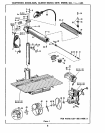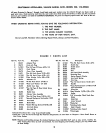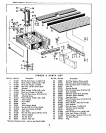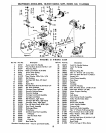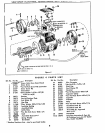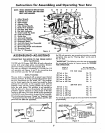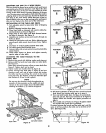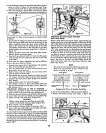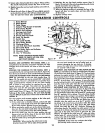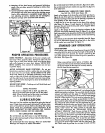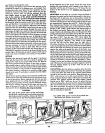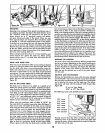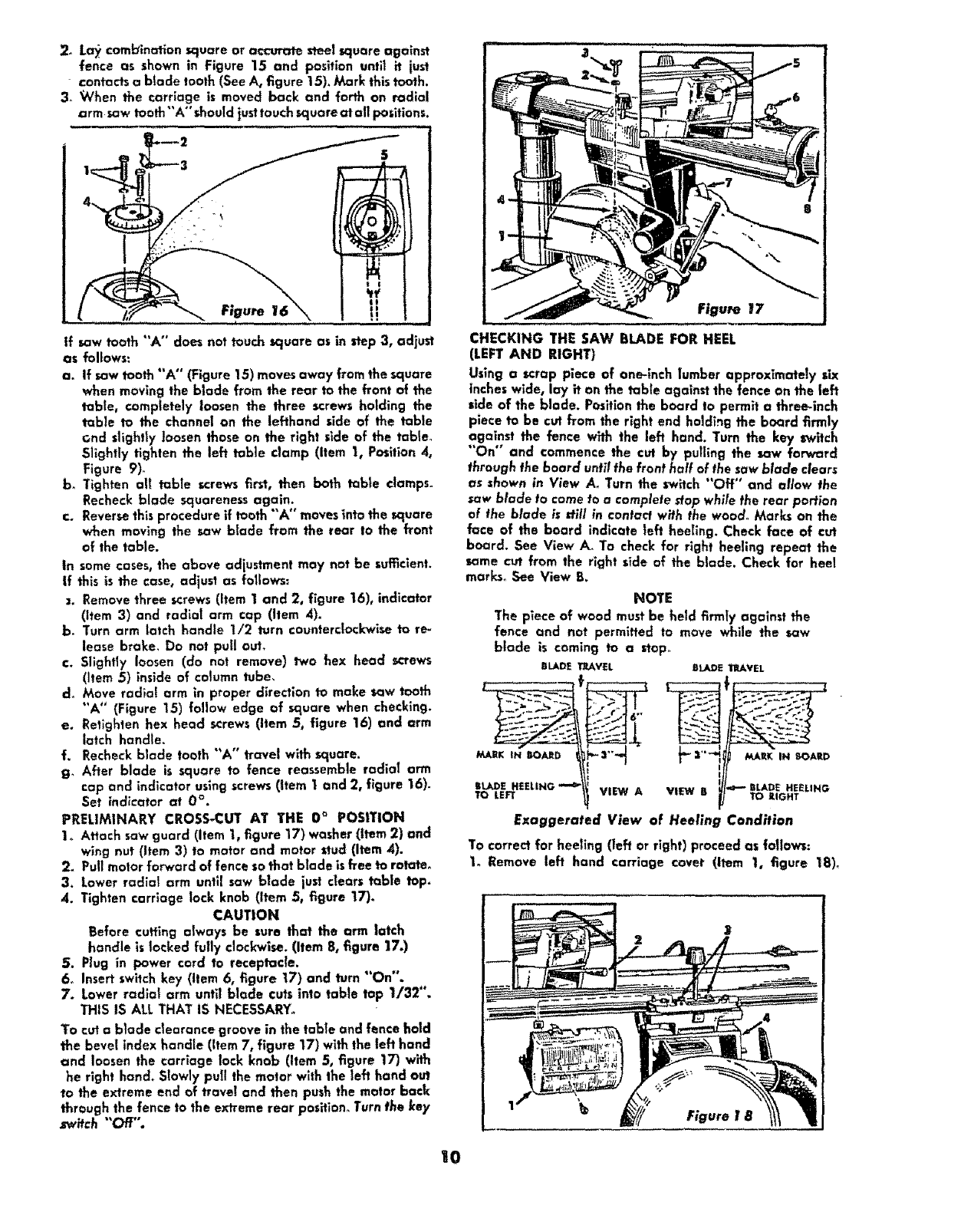
2o Lay combination square or accurate steel square against
fence as shown in Figure 15 and position until it just
contacts a blade tooth (See A, figure 15). Mark this tooth.
3_ When the carriage is moved back and forth on radial
arm saw toofi_"A" should iust touchsquare at all po_itions.
tf saw tooth "A" does not touch square as in step 3, adjust
as fellows:
a. If saw tooth "A" (Figure 15) moves away from the square
when moving the blade from the rear to the front of the
table, completely loosen the three screws holding the
table to the channel on the |efthand side of the table
_nd slightly loosen those on the right side of the tableo
Slightiy tighten the left table clamp (Item 1, Position 4,
Figure 9)_
bo Tighten all table screws first, then both table damps.
Recheck blade squareness again.
c. Reverse this procedure if tooth "'A" movesinto the square
when moving the saw blade from the rear to the front
of the table.
tn some cases, the above adjustment may not be sufficient.
if this is the case, adjust as follows:
_. Remove three screws (Item 1 and 2, figure 16), indicator
(Item 3) and radial arm cap (Item 4).
b_ Turn arm latch handle 1/2 turn counterc!ockwi_ to re-
lease brake, Do not pull out_
c. Slightly loosen (do not remove) two hex head screws
(Item 5) inside of column tube,
do Move radial arm in proper direction to make saw tooth
"'A" (Figure 15) follow edge of square when checking.
e. Retightee hex head screws (Item 5, figure 16) and arm
latch handte.
f. Recheck blade tooth "A" travel with square.
g_ After blade is square to fence reassemble radial arm
cap and indicator using screws (item 1 and 2, figure 16).
Set indicator at 0 °.
PRELIMINARY CROSS-CUT AT THE 0 _ POSITION
1o Attach saw guard (Item 1, figure 17) washer (item 2) and
wing nut (Item 3) to motor and motor s_tud(Item ,4).
2. Pull motor forward of fence so that blade isflee to rotate°
3. Lower radio1 arm untff sow blade just clears table top.
,4. Tighten carriage lock knob (Item 5, figure 17).
CAUTION
Before cutting always be sure that the arm latch
handle is locked fully clockwlse. (Item 8, figure 17.)
5. Plug in power cord to receptacle.
6. Insert switch key (Item 6, figure 17) and turn "On".
7. Lower rodial arm until blade cuts into tabte top 1/32".
THIS tS ALL THAT IS NECESSARY°
To cut a blade clearance groove in the table and fence hold
the bevel index handle (item 7, figure 17) with the left hand
and loosen the carriage lock knob (Item 5, figure 17) with
he right hand. Slowly pull the motor with the left hand out
to the e_reme end of travel and then push the motor back
through the fence to the e_treme rear posltion_Turn the key
Jwitch "OFF",
Figure 17
CHECKING THE SAW BLADE FOR HEEL
(LEFT AND RIGHT)
Using a scrap piece of one-lnch lumber approximately six
inches wide, lay it on the table against the fence on the left
side of the blade. Position the board ta permit a three-inch
piece to be cut from the right end holding the beard firmly
against the fence wffh the left hand. Turn the key switch
"On" and commence the cut by pulling the saw forward
through the board until the front half of the saw blade clear_
as _hown in View A_ Turn the switch "Off" and atlow the
saw blade to come to a complete _op while the rear portion
of the blade is r_itl in contact with the wood, Marks on the
face of the board indicate left heeling. Check face of cut
board. See View A_ To check for right beefing repeat the
same cut from the right side of the blade. Check for heel
marks° See View B.
NOTE
The piece of wood must be held firmly against the
fence and not permitted to move while the saw
blade is coming to a stop°
_0 "r_VEL ,_OE _U_VEL
%.
/_LnK IN DOA_O _'_ :ll_''' ktAf_ IN _AIO
St,ADE HEELING _ _ BLADE HEELING
TO LEFT VIEVV A V|_ B. TO li:IGHr
Exaggerated View of Heeling Condition
To correct for heeling (left or right) proceed as fallows:
1o Remove left hand carriage cover (Item 1, figure 18)o
Figure 1 8
10




